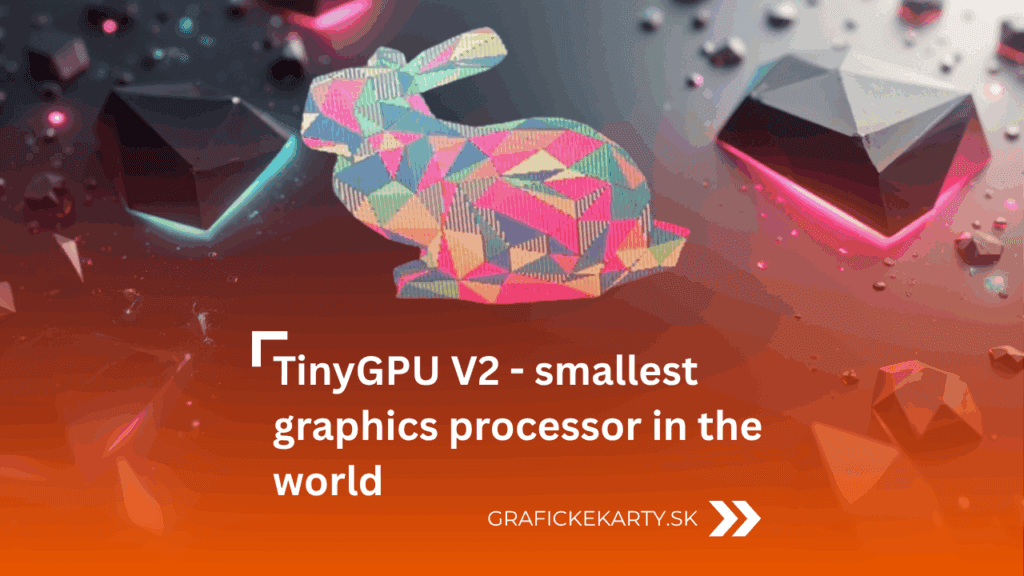In a world where graphics cards are outpacing each other in billions of transistors and record-breaking performance, a project has emerged that shows the exact opposite. TinyGPU v2.0 is the world’s smallest functional graphics processor – a miniature chip that proves that even 200,000 or so transistors are enough to create a full 3D display.
Behind the project is developer Pongsagon Vichit, who decided to build his own GPU completely from the ground up. His goal wasn’t to beat NVIDIA or AMD, but to show how simple and elegant a GPU core can be if we get rid of unnecessary complexity. The result is TinyGPU v2.0 – an open, functional and extremely minimalistic GPU chip that works as both a living experiment and an educational tool.
How TinyGPU v2.0 works
TinyGPU v2.0 runs on an FPGA platform that allows it to be tested under real-world conditions. Unlike modern graphics cards that process millions of triangles per second, this chip can handle approximately 1,000 “triangles” at 320 × 240 pixel resolution and 4-bit color depth.
Triangles are the basis of all 3D graphics. Every object we see in a game or animation – from characters to buildings – is made up of thousands of tiny triangles. The GPU then calculates how the objects should be transformed, lit, where they should be placed in the scene, and how they should appear on the screen. TinyGPU v2.0 can perform this process – simpler, slower, but completely autonomously.
The architecture includes a custom rasterization pipeline with basic graphics functions such as transformation, lighting, hidden area removal or flat shading. Although these are numbers that look archaic today, the result is fully functional – rotating 3D objects in real time, responding to input from the gamepad.
The second generation brought optimized memory management and more efficient geometry handling. As a result, v2.0 behaves more stable and smoother than its predecessor. This is not a gaming GPU, but a fascinating demonstration of how graphical computing can be understood in its purest form – without AI, DLSS or ray tracing.
Design and meaning of TinyGPU v2.0
TinyGPU v2.0 is not about performance, it’s about thought. At a time when high-end graphics cards cost thousands of euros and require both robust cooling and 1200-watt power supplies, here comes a chip that changes the way we look at GPUs from the ground up. This mini GPU is open, simple and easy to understand. It proves that visualizing three-dimensional space doesn’t have to be the domain of giants with huge budgets, but also of individuals with the courage to experiment.
The chip has negligible power consumption, occupies only a few square millimeters, and yet can process a 3D scene completely on its own – without the help of a CPU. Inside it is everything that makes up the core of a GPU: object transformation, lighting, shading and rasterization. That’s why this GPU has become a popular educational tool among developers and students who want to understand how the GPU pipeline works in practice.
The project is completely open-source and freely available. Anyone can view the source code, modify it or even order a physical version of the chip through the Tiny Tapeout initiative. Version 2.0 is thus not just a virtual design – it’s a real silicon chip that can be built by anyone with a taste for experimentation.
If you want to see the TinyGPU v2.0 in action, you can also watch a video in which the chip is tested directly on an FPGA board. It shows its realistic processing of both “triangles” and rotating 3D objects in a simple visualization
Conclusion
TinyGPU v2.0 is proof that size and performance are not everything. This miniature chip doesn’t impress with FPS numbers or ray tracing, but it reminds us that true innovation comes from understanding, not billions of transistors. It’s a project that combines simplicity, creativity and a passion for hardware into one compact piece of work.
At a time when graphics cards are outgrowing computers themselves, TinyGPU v2.0 comes as a reminder that the beauty of technology also lies in its comprehensibility. And perhaps this tiny chip is the biggest proof that there is still room for real innovation in the GPU world.

